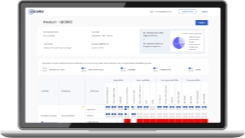
In today's dynamic digital landscape, the role of a Vice President (VP) of IT Technology has become increasingly pivotal. Tasked with steering an organization's technological direction, they ensure that companies remain competitive and innovative.
Understanding the multifaceted responsibilities of a VP of Technology is crucial for businesses aiming to thrive in 2025 and beyond. We’ll dive into a VP of Technology's top seven roles and responsibilities, providing insights and training course suggestions from Edstellar to keep you competitive in 2025 and beyond.
What Does a Vice President of Technology Do?
VP of Information Technology (IT) is responsible for overseeing the strategic direction and management of a company's technological initiatives. They lead the development and implementation of technology strategies that support organizational objectives.
Their role involves managing IT resources, ensuring data security, and staying abreast of emerging technological trends to maintain a competitive edge. A study by ZipRecruiter revealed over 11,800 job postings for VP of technology positions across the United States, indicating a robust demand for senior technology leaders.
Let's dive into the top seven roles and responsibilities of the VP of technology and the recommended training courses to transform your career.
The 7 Vital Roles & Responsibilities of Vice President of Technology

1. Strategic Technology Planning:
A VP of IT Technology shapes a company’s long-term technological vision. They develop and implement strategies that ensure the organization remains competitive and adaptable in an ever-evolving digital landscape. By aligning technology initiatives with business objectives, they drive efficiency, scalability, and sustainability.
Successful technology planning requires a deep understanding of industry trends and emerging technologies. They assess current infrastructure, identify gaps, and create roadmaps for future advancements. VPs of technology enable seamless operations and business success.
Recommended Training Course: Strategic Planning Training
2. Team Leadership and Development:
Leading a high-performing technology team is one of the VP’s most significant responsibilities. They oversee recruitment, training, and professional development to ensure the company has a skilled and motivated workforce. A strong leadership approach fosters a culture of innovation, encouraging employees to experiment with new solutions and optimize workflows.
Effective team development contributes to higher efficiency and technological excellence. Continuous learning and mentorship are critical in the fast-evolving tech industry. They must implement training programs, provide growth opportunities, and establish clear career paths.
Recommended Training Course: Introduction to Leadership Training
3. Budget Management:
The VP of Information Technology is responsible for overseeing the technology budget, and ensuring financial resources are allocated efficiently. They evaluate investment opportunities, such as new software, hardware, and infrastructure upgrades, while balancing cost-effectiveness.
Cost optimization requires making informed financial decisions based on performance data and projected returns. They must justify spending by demonstrating tangible benefits, such as increased efficiency or revenue growth.
Recommended Training Course: Finance and Budgeting Training
4. Data Security and Compliance:
Protecting sensitive company and customer data is a top priority for the Vice President of IT Technology. They establish cybersecurity policies, implement encryption protocols, and ensure compliance with industry regulations such as GDPR & CCPA. By proactively addressing security threats, they safeguard the organization against data breaches and cyberattacks.
Regulatory compliance is an ongoing process requiring constant monitoring and adaptation. The VP must stay informed about evolving laws and industry standards to mitigate legal risks. Implementing best practices for data management and employee training helps reinforce security across all departments.
Recommended Training Course: Data Privacy and Security Training
5. Innovation Management:
Staying ahead of technological advancements is crucial for business success. The VP of Technology continuously explores emerging trends, assessing their potential impact on company operations. By leading pilot projects, they test and integrate innovative solutions that drive growth and efficiency.
Innovation management also involves fostering a culture that embraces change and experimentation. VP of technology collaborates with different teams to identify technological opportunities that align with business goals. By encouraging a forward-thinking mindset, they ensure the company remains adaptable and prepared for future advancements.
Recommended Training Course: Business Model Innovation Training
6. Vendor and Partner Relations:
Managing relationships with external vendors and technology partners is vital for securing the best tools and services. The VP negotiates contracts, ensuring cost-effective agreements and favorable terms for the company. Strong vendor partnerships help maintain access to the latest technological solutions.
Beyond procurement, the VP collaborates with partners to co-develop innovative solutions. The strategic alliances enhance the company’s ability to adopt new technologies quickly. By fostering strong relationships with industry leaders, the organization gains a competitive advantage in the tech landscape.
Recommended Training Course: Supplier Relationship Management Training
7. Performance Monitoring and Analysis:
Tracking technology performance ensures continuous improvement and operational efficiency. The VP implements key performance indicators (KPIs) to measure system reliability, user experience, and overall effectiveness. By analyzing data, they identify areas for optimization and drive strategic enhancements.
Making data-driven decisions is essential for improving technology operations. The VP uses insights from performance reports to refine strategies and allocate resources effectively. Proactive monitoring enables the organization to address potential issues before they impact business processes, ensuring seamless technology integration.
Recommended Training Course: Performance Testing Training
Salaries Across Countries For Vice President of Technology
The compensation for a Vice President of IT Technology varies significantly across different countries, influenced by factors such as industry, and regional economic conditions.
- United States: the median annual salary for a Vice President of Technology is approximately $246,000, with the top 10% earning up to $401,000.
- United Kingdom: In the UK, the average salary for this role is around £126,000 per year, though this can vary based on location and industry.
- Canada: Canadian VPs of Technology earn an average of $166,993 annually, with higher salaries in major cities like Toronto and Vancouver.
- Australia: In Australia, the average annual salary is approximately AUD 170,89 with variations depending on the specific region and industry sector.
- Germany: German professionals in this role can expect an average annual salary of €149,759, with higher compensation in technology hubs like Berlin and Munich.
Qualifications and Skills Required For Vice President of Technology
To excel as a Vice President of Technology (IT), individuals must possess a blend of advanced education, extensive experience, and a diverse skill set.
- A master's degree in Computer Science, Information Technology, or a related field. Some positions may prefer candidates with an MBA or other advanced degrees.
- Extensive experience in the technology sector, including roles in software development, IT infrastructure management, and digital transformation projects, is essential.
- Extensive understanding of modern technology advancements, including artificial intelligence, cloud infrastructure, cybersecurity, and data analytics.
- Proven expertise in leadership and team development, emphasizing employee growth and long-term retention.
- Outstanding communication and relationship-building abilities, ensuring complex technical concepts are easily understood by non-technical audiences.
- Well-versed in budget management and resource allocation to optimize financial and operational efficiency.
- Highly skilled in analytical thinking and strategic decision-making to address challenges and drive innovation.
What Certifications Does the Vice President of Technology Should Attain?
Earning relevant certifications can enhance a VP of Technology's credentials and demonstrate expertise in specific areas.
- Project Management Professional (PMP): validates skills in project management, crucial for overseeing technology initiatives.
- Certified Information Systems Security Professional (CISSP): demonstrates expertise in information security, essential for managing data protection and compliance.
- Certified Information Technology Manager (CITM): focuses on IT management skills, including strategic planning and resource management.
- AWS Certified Solutions Architect: highlights proficiency in designing and deploying scalable systems on Amazon Web Services, for organizations utilizing cloud services.
- ITIL Foundation Certification: provides knowledge of IT service management best practices, aiding in the efficient delivery of IT services.
Day-to-Day Activities and Deliverables List of Vice President of Technology
- Develop and implement technology strategies aligned with business goals
Creating a strong technology strategy ensures that business objectives are supported through innovation and efficiency.
- Oversee IT operations and ensure system security and stability
Managing IT operations requires a proactive approach to maintaining system performance, security, and uptime.
- Lead and mentor technology teams to enhance productivity and innovation
A VP of Technology fosters a culture of continuous learning and collaboration within IT teams. Guidance and career development opportunities improve performance.
- Manage technology budgets, investments, and financial planning
Strategic budget management ensures that IT expenditures align with business priorities while maximizing return on investment.
- Monitor and analyze system performance and recommend improvements
Continuous system monitoring helps identify inefficiencies and areas for optimization. Implementing performance enhancements ensures seamless business operations.
- Lead digital transformation initiatives and emerging technology adoption
Spearheading digital transformation helps organizations stay ahead of industry trends and customer expectations.
- Conduct risk assessments and implement cybersecurity measures
Regular risk assessments identify potential vulnerabilities within IT infrastructure. Implementing proactive cybersecurity measures safeguards company data.
- Report technology developments and progress to executive leadership
Providing regular updates on IT advancements ensures transparency and informed decision-making.
5 Key Departments a Vice President of Technology Works With
1. IT Department: The IT Department is a primary collaborator for the VP of Technology, as it handles infrastructure management, cybersecurity, and system maintenance. The VP ensures that IT strategies align with business goals, enabling seamless operations and technological growth. Close coordination with IT teams helps implement new technologies.
2. Product Development Department: The Product Development Team relies on the VP of Technology for guidance on integrating emerging technologies into products and services. By working together, they enhance user experience, improve functionality, and stay ahead of market trends. The VP ensures that digital solutions are scalable and innovative.
3. Finance Department: The Finance Department plays a crucial role in budgeting and resource allocation for technology initiatives. The VP collaborates with finance leaders to secure funding for digital transformation projects while ensuring cost-effectiveness. Strategic financial planning helps balance innovation with profitability, maximizing the return on technology investments.
4. Operations Department: The Operations Department depends on technology to streamline business processes and improve efficiency. The VP of Technology works closely with operations leaders to implement automation, data-driven decision-making, and cloud-based solutions. By optimizing workflows, they help the organization achieve greater productivity and scalability.
5. HR Department: The Human Resources (HR) Department partners with the VP of Technology to recruit, train, and retain top tech talent. They collaborate on workforce planning, digital training programs, and employee engagement strategies. Ensuring a skilled and motivated tech team is essential for driving innovation and maintaining a strong company culture.
Roadmap to Become a Vice President of Technology

1. Educational Background: Earn a Bachelor's degree in Computer Science, Information Technology, or a related field. Pursue a Master's degree (e.g., MBA, MSc in IT) to enhance leadership and business acumen.
2. Gain Hands-on Experience: Start as a software developer, IT analyst, or system administrator. Progress into managerial roles such as IT Director or Chief Technology Officer.
3. Develop Key Skills: Master cybersecurity, cloud computing, AI, and digital transformation. Strengthen leadership, strategic planning, and financial management abilities
4. Earn Certifications: Obtain industry-recognized certifications such as PMP, CISSP, CITM, and AWS Certified Solutions Architect
5. Build a Strong Professional Network: Attend industry conferences, join tech communities, and engage with thought leaders
6. Stay Updated on Emerging Trends: Continuously learn and adapt to new technologies, cybersecurity threats, and industry advancements
7. Secure an Executive Role: Leverage experience and expertise to transition into a VP of Technology position
Conclusion
The role of a Vice President of Technology is indispensable in shaping a company's future in an increasingly digital world. By overseeing strategic technology planning, they ensure that businesses remain adaptable and competitive in the face of rapid advancements. Their leadership fosters innovation, empowering teams to develop cutting-edge solutions that drive efficiency and growth.
Managing budgets effectively allows the VP of IT Technology to optimize resources while making strategic investments in emerging technologies. They play a crucial role in ensuring robust cybersecurity measures and regulatory compliance, safeguarding sensitive business and customer data. Innovation management keeps the company ahead of industry trends, allowing for seamless integration of new technological solutions.
Collaboration with vendors and partners strengthens the company’s ability to access the latest tools and advancements in technology. Through performance monitoring and data analysis, the VP ensures continuous improvement and efficiency in technological operations. Enroll in Edstellar training courses to transform your career journey. You can also analyze your competencies and gaps using our Skill Matrix Software.
Explore High-impact instructor-led training for your teams.
#On-site #Virtual #GroupTraining #Customized
Edstellar Training Catalog
Explore 2000+ industry ready instructor-led training programs.

Coaching that Unlocks Potential
Create dynamic leaders and cohesive teams. Learn more now!


Want to evaluate your team’s skill gaps?
Do a quick Skill gap analysis with Edstellar’s Free Skill Matrix tool

Stay informed on L&D best practices
Get periodic updates on learning and development industry trends, expert insights, success stories and innovative training practices from Edstellar.
.svg)
Featured Post
.webp)
Contact Us
Submit your Training Requirements below and We'll get in touch with you shortly.
.svg)



.svg)


.svg)

.svg)
.svg)
.svg)

